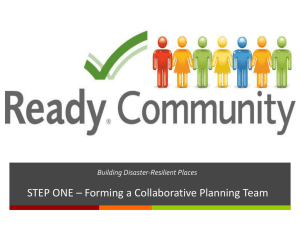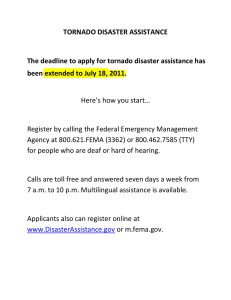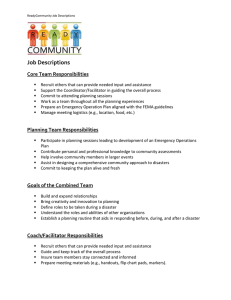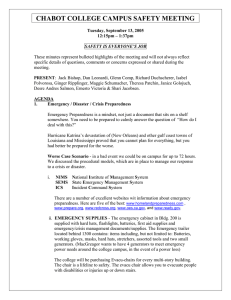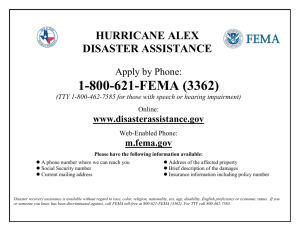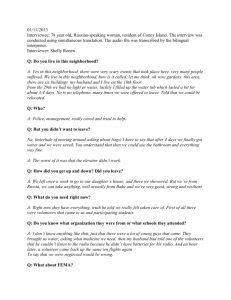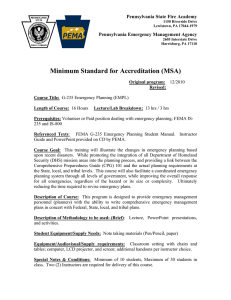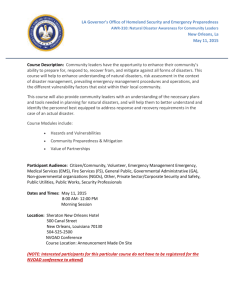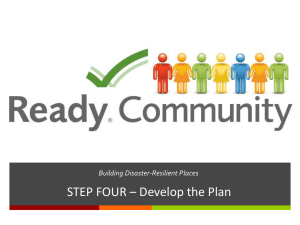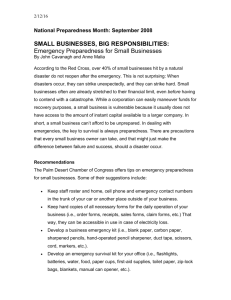Planning Team
advertisement
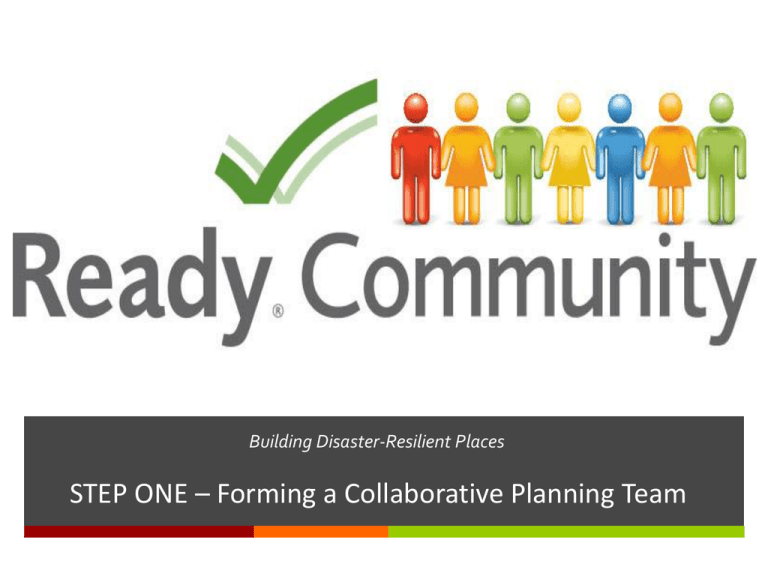
Building Disaster-Resilient Places STEP ONE – Forming a Collaborative Planning Team 2 A Mini-Quiz What is minimum amount of time you should be prepared to survive on your own in a disaster? 72 hours = 3 days The first 3 is on me 3 Rural Challenges Harder to Plan Longer to Receive Aid Rural places seldom have dedicated staff support. Remote locations are more difficult to reach. Emergency planners often wear multiple “hats.” Communication may be more difficult. Help begins where the greatest number of people are impacted. 4 FEMA’s CPG 101 Comprehensive Preparedness Guide Purpose of CPG 101: Conduct community-based planning that engages the whole community Ensure plans are developed through an analysis of risk Prioritize plans to support their seamless transition from development to execution Integrate and synchronize efforts across all levels of government Become compliant with FEMA’s guidelines for emergency preparedness 5 What is Involved? Step 1: Form a Collaborative Planning Team Step 1: Step 2: Step 3: Step 4: Step 5: Step 6: Step 2: Understand the Situation Step 3: Determine Goals & Actions Step 4: Plan Development Step 5: Plan Preparation, Review, & Approval Form a Collaborative Planning Team Understand the Situation Determine Goals & Actions Develop the Plan Prepare, Review, & Approve the Plan Implement & Maintain the Plan Step 6: Plan Implementation & Maintenance 6 Layers of Involvement Community Planning Team Community Coach & Emergency Manager Core Team 7 Purpose of the Emergency Manager Has the legal responsibility for overseeing emergency preparedness and response Taps supporting resources, most of which come through government avenues Provides expert guidance for the plan Ensures important connections between community, county, state, and federal plans 8 Purpose of a Community Coach Supports the planning effort, from start to finish Helps organize the Core Team and Planning Team Facilitates the process that aids the Team in preparing a plan Helps coordinate community involvement Provides links to data and expertise available through the partners 9 Core Team Responsibilities Guide the overall process Community Recruit others Planning Team Core Team Commit to participating in sessions Work as a team Prepare Emergency Operation Plan 10 Planning Team Responsibilities Community Planning Team Participate in planning sessions Contribute to community assessments Help involve community Core Team Assist in designing the emergency plan Commit to keeping the plan current 11 Goals of the Planning and Core Team Build and expand relationships Bring creativity and innovation to planning Define roles to be taken during a disaster Understand roles and abilities of others Establish a planning routine 12 Who Should Be at the Table? 13 FEMA Suggests… Social Services Agriculture & Farming National Guard Education Civic Organizations Utilities Health Services Emergency Manager Fire Services Children’s Services Planning Team Law Enforcement 14 Considering Special Needs What people or groups are most likely to have difficulty responding to a disaster in your community? 15 How to Involve Others in Planning Community Organizations and Individuals Disaster Core Team Creating a Win-Win Partnership 16 When to Involve the Community Two Touch-Points in the Planning Process Step 1: Form a Collaborative Planning Team Step 2: Understand the Situation Verify and strengthen information gathered Step 3: Determine Goals & Actions Step 4: Plan Development Step 5: Plan Preparation, Review, & Approval Step 6: Plan Implementation & Maintenance Communicate the plan. Involve the community in staying ready 17 Are We Ready? 18 Questions & Discussion Commitments Tentative timeline Who else should be invited: • Core team • Planning team Next meeting date Other discussion/questions 19 Contact Information Building Disaster-Resilient Places
